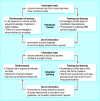What is the evidence that postgraduate teaching in evidence based medicine changes anything? A systematic review
- PMID: 15514348
- PMCID: PMC524555
- DOI: 10.1136/bmj.329.7473.1017
What is the evidence that postgraduate teaching in evidence based medicine changes anything? A systematic review
Abstract
Objective: To evaluate the effects of standalone versus clinically integrated teaching in evidence based medicine on various outcomes in postgraduates.
Design: Systematic review of randomised and non-randomised controlled trials and before and after comparison studies.
Data sources: Medline, Embase, ERIC, Cochrane Library, DARE, HTA database, Best Evidence, BEME, and SCI.
Study selection: 23 studies: four randomised trials, seven non-randomised controlled studies, and 12 before and after comparison studies. 18 studies (including two randomised trials) evaluated a standalone teaching method, and five studies (including two randomised trials) evaluated a clinically integrated teaching method.
Main outcome measures: Knowledge, critical appraisal skills, attitudes, and behaviour.
Results: Standalone teaching improved knowledge but not skills, attitudes, or behaviour. Clinically integrated teaching improved knowledge, skills, attitudes, and behaviour.
Conclusion: Teaching of evidence based medicine should be moved from classrooms to clinical practice to achieve improvements in substantial outcomes.
Figures


Comment in
-
Integrating evidence-based teaching into to clinical practice should improve outcomes.Evid Based Dent. 2005;6(2):47. doi: 10.1038/sj.ebd.6400332. Evid Based Dent. 2005. PMID: 16208393
References
-
- Parkes J, Hyde C, Deeks J, Milne R. Teaching critical appraisal skills in health care settings. Cochrane Database Syst Rev 2001;(3): CD001270. - PubMed
-
- Taylor R, Reeves B, Ewings P, Binns S, Keast J, Mears R. A systematic review of the effectiveness of critical appraisal skills training for clinicians. Med Educ 2000;34: 120-5. - PubMed
-
- Coomarasamy A, Taylor R, Khan KS. A systematic review of postgraduate teaching in evidence-based medicine and critical appraisal. Med Teach 2003;25: 77-81. - PubMed
-
- Linzer M, Brown JT, Frazier LM, DeLong ER, Siegel WC. Impact of a medical journal club on house-staff reading habits, knowledge, and critical appraisal skills. A randomized control trial. JAMA 1988;260: 2537-41. - PubMed
Publication types
MeSH terms
LinkOut - more resources
Full Text Sources
